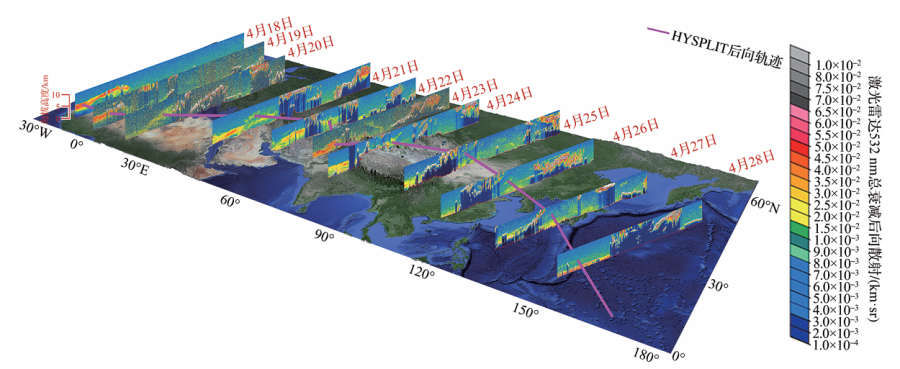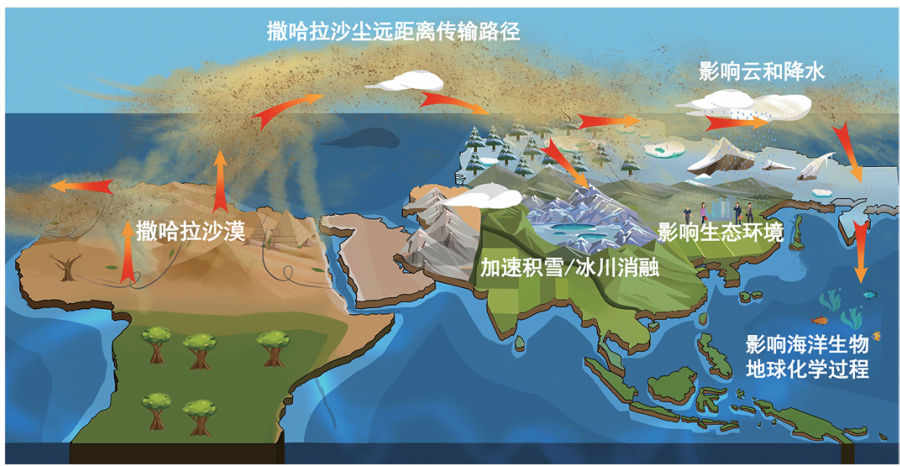Recently, Professor Huang Zhongwei's team from the College of Atmospheric Sciences at Lanzhou University published a review paper titled "The Patterns of Eastward Transport of African Dust and Its Climatic and Environmental Effects" in the high-level journal *Advances in Earth Sciences*. The paper was selected as the cover article for the first issue of 2025. It summarizes the third route of long-distance eastward transport of Saharan dust to East Asia and its profound impacts on climate, environment, and ecosystems. The paper emphasizes that under the backdrop of global warming, there is an urgent need to strengthen research on the mechanisms of cross-border eastward transport of Saharan dust and their climatic, environmental, and ecological effects.
Traditional research suggests that Saharan dust primarily affects the Americas by crossing the Atlantic to the west or Europe to the north, but its eastward transmission to East Asia remains unexplored systematically. Professor Huang Zhongwei's team, based on multi-source observations and numerical simulations, quantified the transmission pattern of Saharan dust spanning nearly ten thousand kilometers to reach East Asia, proposing that its contribution to the total dust load in East Asia during spring can be as high as 35.8%, with an average annual transmission volume of 33.05 ± 9.78 Tg. This discovery challenges the established understanding of dust transport pathways in the scientific community and reveals a "hidden channel" in the global dust cycle.

Figure 1 Long-distance transport of African dust in the East Asian dust event in April 2017 based on CALIPSO and HYSPLIT tracking
The long-distance eastward transport of Saharan dust has significant impacts on global climate, environment, ecology, and human health. Long-traveled dust often resides in the upper atmosphere, where it can alter atmospheric thermal structure by absorbing and scattering solar radiation (direct effect), and regulate cloud formation processes through acting as cloud condensation nuclei or ice nuclei (indirect effect), thereby influencing regional and even global water cycles and energy balances. The deposition of dust provides key nutrients such as iron and phosphorus to marine plankton and the Amazon rainforest, aiding in carbon sequestration; however, dust deposited on glaciers accelerates their melting, and the pathogens it carries may cause respiratory diseases, posing a threat to public health safety. As a "natural link," dust connects deserts with oceans and land with the atmosphere, reshaping global biogeochemical cycles, and minor changes in its transboundary transport can trigger cascading responses at the ecosystem level.

Figure 2 Schematic diagram of the path and influence of the long-distance transmission of Saharan dust to East Asia
Despite significant progress in research, global warming is altering the patterns of dust emission, transport, and deposition. The expansion of arid regions in North Africa may intensify dust activity, while circulation adjustments could shift transport pathways. To address this, Professor Huang Zhongwei's team calls for the establishment of a comprehensive three-dimensional dust observation system covering Africa, the Middle East, Central Asia, and East Asia. They also advocate for the development of high-resolution, high-precision Earth system models that integrate multiple processes and elements of dust dynamics, as well as enhanced international cooperation to jointly tackle cross-border dust pollution and climate risks.
The study emphasizes that dust is not only an environmental problem, but also a "geochemical link" connecting deserts, oceans and ecosystems. Its research is of great significance to achieving the goal of "carbon neutrality" and ecological security. To address climate change, we need to pay more attention to seemingly distant but closely related natural processes with a more open vision.
The first author of the paper is Professor Zhongwei Huang. This research was supported by the National Natural Science Foundation of China (No. W2411029,423B2503) and the Major Science and Technology Project of Gansu Province (No.24ZDWA006).
Welcome to read the team's related work articles:
[1] Liu, Q., Huang, Z., Hu, Z., Dong, Q., & Li, S. (2022). Long‐Range Transport and Evolution of Saharan Dust Over East Asia From 2007 to 2020. Journal of Geophysical Research: Atmospheres, 127(18). https://doi.org/10.1029/2022JD036974
[2] Zhou, T., Zhou, X., Yang, Z., Córdoba-Jabonero, C., Wang, Y., Huang, Z., Da, P., Luo, Q., Zhang, Z., Shi, J., Bi, J., & Alikhodja, H. (2024). Transboundary transport of non-east and East Asian dust observed at Dunhuang, northwest China. Atmospheric Environment, 318, 120197. https://doi.org/10.1016/j.atmosenv.2023.120197
[3] 黄忠伟, 刘千滔, 董青青, 胡志远, 张笑琳, 李正鹏, 王雍恺. 非洲沙尘东传的规律及其气候环境效应. 地球科学进展[J], 2025, 40(1): 1-14 DOI:10.11867/j.issn.1001-8166.2025.004
